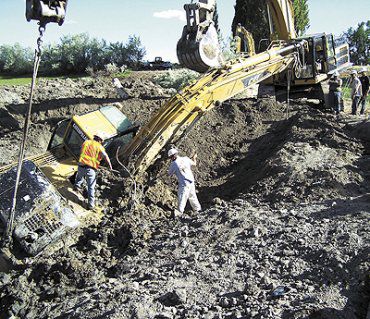Craig Johansen of Johansen and Tuttle reported the progress of the Cottonwood Creek Irrigation Company’s pressurized irrigation projects. The Clipper/Western Water Irrigation Improvement Project, has been divided into two phases because of the funding. “We have funding from the Federal Government to put both phases in, but the government held half the money until fiscal year 2012 which will begin the first of October. We bid the first phase and are working on that one. We will bid the second phase possibly in September. That will put everything currently irrigated by the Clipper/Western Canal under a pressurized sprinkler irrigation system,” said Johansen.
“The pipe line is now entering the Jay Mark Humphrey property West of Orangeville along the Coal Haul Road and moving along quite well. This pipeline will be running water from a proposed reservoir. The reservoir has not been built yet. The reservoir will be in the Adobe Wash across the highway from PacificCorp’s Central Warehouse and South of XTO. We will be running a big line from that reservoir down the Coal Haul Road to take in all of the land that is presently flood irrigated under the Clipper and Western Canals.
“We started on the far South end of this project. The first phase started on Ross Huntington’s property and is moving north. All of the farms on the south end of the project will be finished in the first phase. The first phase of the project should be completed this fall. The second phase should be completed by next spring.
“We have not hooked anyone to the system yet and we will not do that for another year.
“The Adobe Wash Dam will go under construction early this fall. We will bid that in August and construction should begin in September. We expect the dam to be complete by mid summer of next year.
“Our next project will be a pipeline from the reservoir to the head of the Western Canal. That project will start this fall as well. This will be called the Adobe Wash Pipeline.
“We have the Clipper/Western Irrigation Improvement Project in two phases. We have the Adobe Wash Reservoir and we have the Adobe Wash Reservoir Pipeline. All four of those projects will be under construction or under contract before the end of this year.
“The first phase of this irrigation project is about 40 percent complete.
“We have programmed these projects to begin sprinkling land in the spring of 2013. We expect everything to be in place in 2013.
“That leaves all of the Blue Cut Canal and all of the Mammoth Canal for a future project. Those projects are all designed and we are just waiting for the funds to become available. These projects could be three to eight years away,” said Johansen
Along with the first phase project came some excitement when a backhoe became stuck in the mire. Terry Larson of The Terry Larson Excavation or TLE Excavation Company from Lindon and Pleasant Grove, said his backhoe had been stuck in the mud three days. A heavy equipment operator for the TLE Company was, at the time, installing a 30 inch pipe line across Clyde Magnuson’s property for the pressurized irrigation system, when the operator had the accident.
The TLE backhoe operator accidentally allowed the backhoe to slip off of some large logs, used as a platform over the mud and sank deep into the liquid mud of the marshy ground. The backhoe was 3/4 buried into the muck. Several attempts were made using other heavy equipment to extract the buried backhoe from the mud were unsuccessful.
Larson said the operator attempted to maneuver the backhoe around and struggled to get it out. But the more he moved the backhoe around the deeper into the mud it went. On July 1, many truck loads of shale were brought from a nearby hill and dumped beside the hole around the stuck backhoe. The shale was used to absorb water in the surrounding mud. Howard Tuttle of Johansen and Tuttle said, “Shale is the best thing we have for getting a backhoe out of the mud because it dries up the mud.”
Two large Caterpiller backhoes were employed putting the truck loads of shale and dirt into the hole around the buried backhoe. The shale absorbed the moisture in the mud. After the mud had dried a bit three large backhoes were used to lift the backhoe partially out of the mud. Later it took two large Caterpiller backhoes and a large D-9 Caterpiller to pull the backhoe from the mud hole it was in.
Matt Hanson from TLE Excavation supervised the extraction of the stuck Caterpiller backhoe. Steve Daley an engineer for Johansen and Tuttle was on hand to observe the process of installing the pipeline and the buried backhoe situation. The backhoe operator safely got out of the mud and the backhoe.
Finally after three days the backhoe was out of the mud hole, bleeding black oil from the engine compartment, and on dry ground once again. The backhoe will need to be washed to get the mud off. The engine still runs, but will have to be serviced as it may have water and dirt in the oil.
Irrigation project in two phases

"In the process of putting in a new irrigation pipeline a backhoe sinks in the mud."
